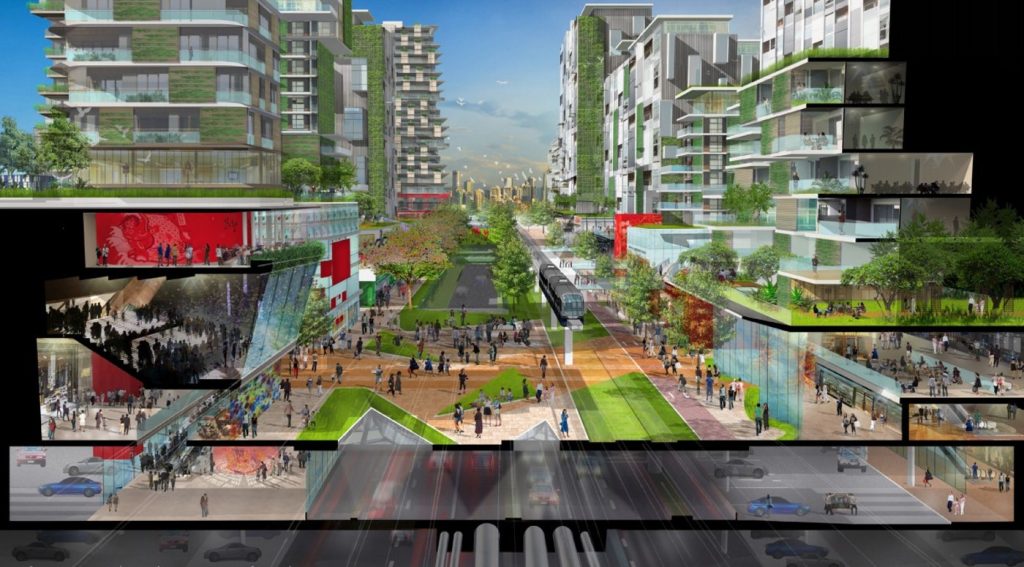
Here’s the plan. We’re starting a wireless biometric crypto-AI blockchain company. Instead of a traditional headquarters, we’re going to buy up 50,000 acres of the desert and start our own city. It’ll look like Blade Runner perched on an Amalfi cliff face and run completely on self absorption and hair product. There will be a centrally located Soylent pump running to home taps and the police will be replaced with armed Ring doorbells. Our neighbors will be Burning Man on one side and a Legitimate Businessman’s Organization on the other.
Interestingly, the most likely part of this idea is founding a city in the desert. Nevada’s Governor Steve Sisolak (D) has proposed legislation to allow corporations to start their own towns. Calling them “Innovation Zones”, the proposal will allow companies in certain high-tech fields to stand up an entity with municipal authority given certain size, investment, and employment measures are sustained. The idea was met with concern about the last century’s company towns and the indentured servitude they created.
The worry is well placed. A municipality with police power only beholden to shareholders comes straight from Robocop. But the mechanism is not absurd. After all, cities are corporations. Incorporation is the literal mechanism used to found a municipality. The only difference between Seattle and Amazon is what part of the Revised Code of Washington their charter was filed under. (Amazon has reorganized in Delaware. Some legislators are likely investigating if Seattle can too.)
Also, the company town might seem like history, but they still exist. Start with Homeowners Associations (HOAs). HOAs are corporations set up by a developer where the voting rights are based on the ownership of land. They transfer as ownership changes. The HOA structure holds community land, maintains community standards, and prevents us from charging golf courses reasonable property taxes according to the King County Tax Assessor.
A certain experimental prototype community of tomorrow is its own, very popular, corporate-owned city. The Reedy Creek Improvement District is Walt Disney World’s private government. The arrangement gave Disney control over its territory, overcame straddling county borders, and prevented annexation by Orlando.
States set up authorities like this all the time, just with slices of power rather than Disney’s whole shebang. There are dozens of quasi-public authorities across Washington. Established by the state or cities, some are for economic development or housing or operating a jail in Des Moines like the South Correctional Entity (SCORE). Personally, I’ve been cheering on House Bill 1173 which will establish a development authority for the Interbay Armory site. These are single purpose districts. To use House Bill 1173 as an example, it just has the power to manage the National Guard’s move to North Bend and take ownership of the property they vacate in Interbay.
Being honest, development authorities are corporations managed by other corporations. Boards for development authorities are filled by the officials running the surrounding incorporated city or members of another authority. They start looking like corporate nesting dolls, just shifting election accountability instead of profits.
So, the Nevada Governor’s proposal is not totally outlandish, but three things do set it apart. First is that it’s an entitlement. Some laws are written so specifically that only a single entity (or county) can qualify. This proposal is broadly written so any qualifying organization that jumps through these particular hoops can set up one of these Innovation Zones. That could open up some very interesting parts of the law related to development rights and vesting.
Also, the proposed law clearly establishes relationships between the new Innovation Zone municipality and the county it’s in. Simply put, Nevada tells its counties to butt out. Once the governing body for the Innovation Zone takes the reins, the county and state agencies are barred from setting up any other management organizations in the zone.
Finally, the proposed Nevada law has an out. As residents begin moving into these planned communities, there is a mechanism for them to take control of the governance. It’s not an HOA-style control either, relying on ownership. It’s a move to legitimate one-person one-vote elections for residents to pick Innovation Zone officials.
So before we poo-poo Nevada and their willingness to throw power to any half-baked vaporware in an open collar, we could take a few notes. Washington’s development authorities do not cut through bureaucracy, they install another level. And our authorities don’t dissolve, they just continue perpetually. Washington could learn from Nevada that our authorities need to be empowered to coordinate with other agencies and given a sunset date or transition to elected governance. Too often, Washington sets up one more body at a very large existing table filled with lingering hulks of decrepit long-standing peers. New authorities should be able to flip the table.

Getting these ground rules fixed in Washington is actually pressing beyond cleaning up the existing pandemonium. Proposals for fast-developing tech towns are always out there. Take the Cascadia Innovation Corridor’s idea of “Hub Cities,” a daisy chain of greenfield developments to absorb hundreds of thousands of new residents. They’re appealing because they’re outside of Washington’s patchwork of city governance and come with flashy graphics of The New.
Something like the desert city idea is going to pop up locally, backed with real money and support. By cleaning up our authorities law with strong goals, powers, and transitions out, Washington can have a functional governance structure ready before it does. We can be ready for Elon’s Epcot at Enumclaw East.
Ray Dubicki is a stay-at-home dad and parent-on-call for taking care of general school and neighborhood tasks around Ballard. This lets him see how urbanism works (or doesn’t) during the hours most people are locked in their office. He is an attorney and urbanist by training, with soup-to-nuts planning experience from code enforcement to university development to writing zoning ordinances. He enjoys using PowerPoint, but only because it’s no longer a weekly obligation.

